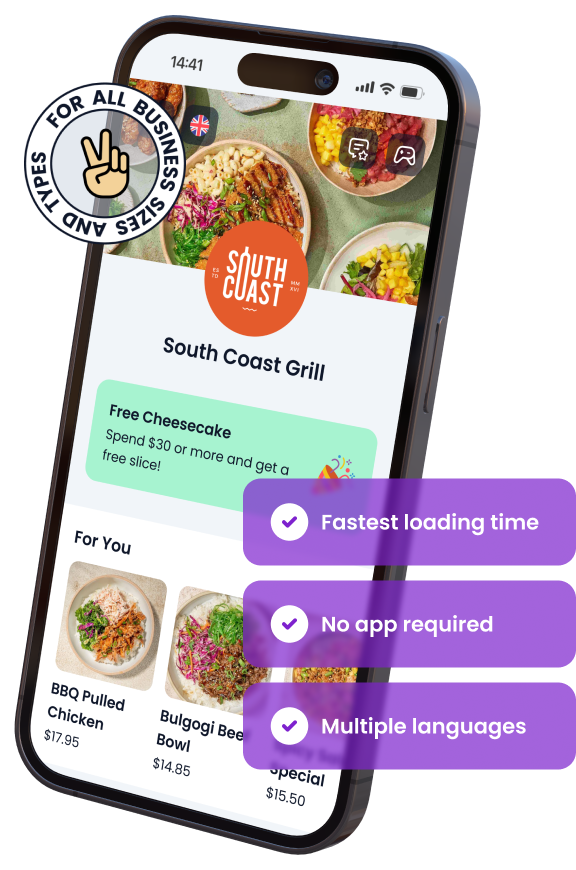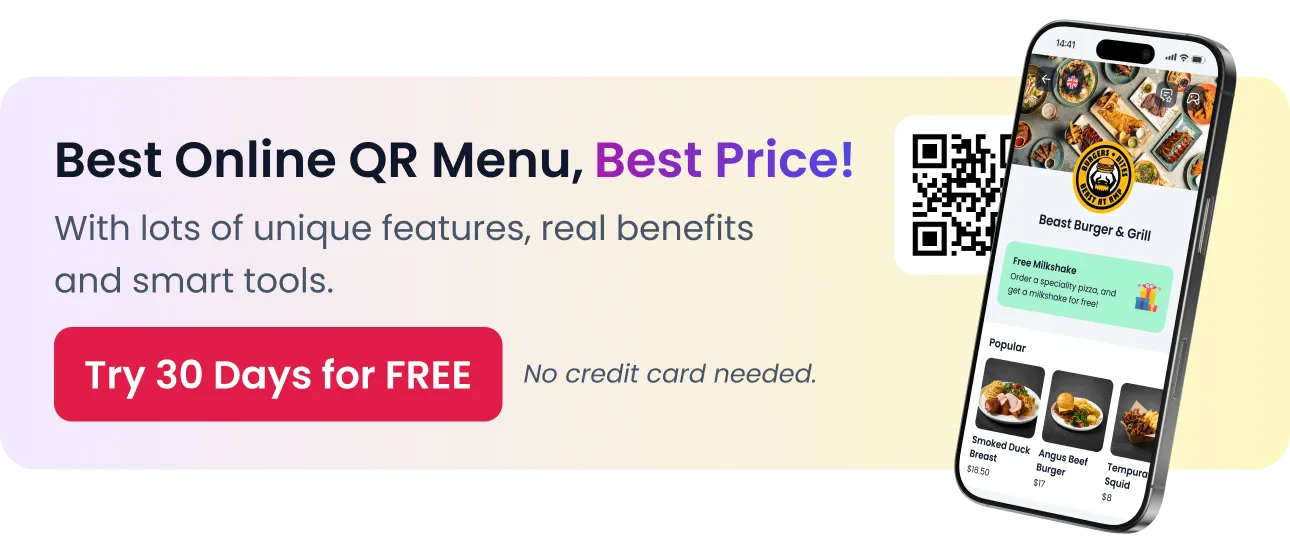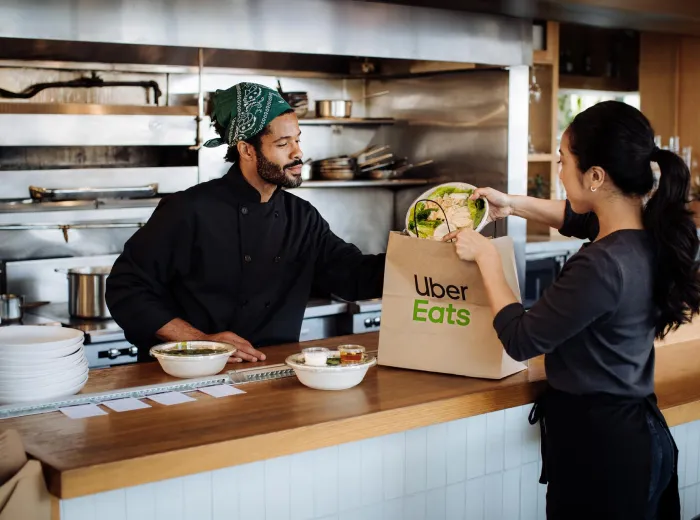

How to Write Great Menu Item Descriptions? Tips & Examples
Crafting compelling menu item descriptions is more than just listing ingredients or stating the obvious; it’s an art that can influence customer choices, enhance their dining experience, and even boost restaurant sales. A well-written menu description can evoke the senses, tell a story, and connect emotionally with diners. Whether it’s a fine dining establishment or a casual café, how you describe your dishes can leave a lasting impression on your guests.
In today’s competitive restaurant landscape, menu descriptions need to do more than just inform. They should entice, inspire curiosity, and reflect your brand’s personality. By focusing on the right words, you can make your menu a powerful marketing tool that captures attention and turns potential orders into definite sales. With the rise of digital menus, this aspect has become even more crucial, as customers often browse menus online before stepping into a restaurant. Let’s dive into the strategies and examples that can help you elevate your menu descriptions and create a memorable dining experience for your customers.
Would you like to listen our deep-dive conversation about this article?
Why Menu Item Descriptions Matter for Restaurants
A restaurant’s menu is often one of the first touchpoints a customer has with the establishment, whether they are dining in or browsing online. A well-crafted menu description not only informs customers but also entices them to make choices that enhance their experience and maximize revenue for the business. Great menu descriptions are a blend of marketing, psychology, and creativity. Here’s why they’re so critical to your restaurant’s success.
Impact on Customer Choices and Sales
The words you use to describe dishes can directly impact what customers order. A well-written description can:
- Highlight unique or high-margin dishes
- Increase the perceived value of a dish
- Encourage customers to try something new or different
For example, a “Grilled Chicken Salad” may sound basic, but “Tender, flame-grilled chicken breast atop a bed of crisp, farm-fresh greens, drizzled with a tangy balsamic glaze” can create a more enticing image that leads to more orders.
Role in Branding and Differentiation
Menu descriptions are also an extension of your restaurant’s brand. Whether you’re positioning your restaurant as upscale, casual, or family-friendly, your descriptions help to:
- Reflect your brand’s personality and tone (e.g., playful, formal, rustic)
- Differentiate your offerings from competitors
- Communicate the unique selling points of your dishes
For instance, if your restaurant has a farm-to-table concept, mentioning locally sourced ingredients and artisan producers can reinforce that brand image and set you apart from generic competitors.
Enhancing Customer Experience with Descriptive Menus
Well-written descriptions can also elevate the customer experience by:
- Setting expectations for taste and portion size
- Educating customers about ingredients they may not be familiar with
- Providing insights into the chef’s inspiration or preparation method
Customers appreciate feeling informed and confident in their choices. Descriptions that communicate these aspects make them feel more engaged and satisfied with their dining experience.
Key Elements of a Great Menu Description
Crafting the perfect menu description requires a thoughtful approach to language, structure, and detail. It’s not just about listing ingredients but about sparking interest and imagination. The right combination of words can make a dish sound irresistible. Here are the key elements every great menu description should include to maximize its impact.
Using Tempting and Descriptive Language
The words you choose can make all the difference in how appealing a dish sounds. Descriptive language helps:
- Paint a vivid picture of the dish in the customer’s mind
- Highlight sensory experiences like taste, texture, and aroma
- Create a sense of indulgence or comfort
For example, instead of simply saying “chocolate cake,” try “Decadent, rich dark chocolate cake with a velvety ganache filling.” These adjectives evoke the taste and texture, making the dish more desirable.
Highlighting Key Ingredients and Flavor Profiles
Your menu descriptions should shine a spotlight on the most exciting or unique ingredients in each dish. This approach helps customers understand what sets your dishes apart and appeals to their taste preferences. Include:
- Star ingredients or unique elements (e.g., truffle oil, heirloom tomatoes, artisanal cheeses)
- Flavor combinations that create intrigue (e.g., sweet and savory, spicy and tangy)
- Dietary-friendly ingredients like gluten-free or vegan options
For example, “Seared Atlantic salmon with a honey-citrus glaze, served alongside garlic-roasted asparagus” sounds more enticing than simply listing “salmon and vegetables.”
Creating a Story Around the Dish
Storytelling can make dishes more memorable and connect customers emotionally to their food. Consider including:
- The origin of the dish (e.g., “Inspired by traditional Sicilian cuisine”)
- How the dish is made or any special preparation techniques (e.g., “slow-cooked for 12 hours”)
- A brief history or cultural significance
For example, “Our signature pizza is made using a 100-year-old family recipe passed down through generations, featuring hand-tossed dough and house-made marinara sauce.”
Mentioning Dietary Information and Allergen Warnings
In today’s health-conscious dining environment, transparency around dietary and allergen information is crucial. Including these details not only improves customer trust but also:
- Helps customers with specific dietary needs (e.g., gluten-free, vegan, dairy-free)
- Encourages inclusivity by catering to a wider audience
- Avoids confusion or mistakes, improving the customer experience
Be sure to clearly label items with icons or notes like “GF” for gluten-free or “V” for vegetarian, or explicitly mention if the dish contains common allergens like nuts or dairy. This can lead to increased customer satisfaction and confidence in their choices.
How to Structure Menu Item Descriptions
The structure of your menu descriptions plays a key role in how customers perceive your dishes. A well-structured description not only provides clarity but also enhances the appeal of the item, making it easier for customers to decide. By carefully organizing the information, you ensure that your descriptions are both informative and enticing. Here are the key strategies for structuring menu item descriptions effectively.
Optimal Word Count for Menu Items
When it comes to menu descriptions, less is often more. The ideal length strikes a balance between being descriptive and concise. Aim for:
- 2-3 sentences per item
- 40-60 words per description
This allows you to include essential details without overwhelming the reader. A brief but engaging description like, “Juicy grilled sirloin steak, served with rosemary potatoes and a peppercorn sauce,” is enough to inform and tempt customers without bogging them down with too much detail.
The Importance of Consistency in Style and Length
Consistency is key to a professional-looking menu. All descriptions should follow the same structure and style to ensure uniformity. Keep in mind:
- Use the same tone of voice across all menu items (e.g., formal, playful, rustic)
- Maintain a consistent length so that no item feels more or less important than another
- Standardize punctuation and capitalization for a clean look (e.g., always use complete sentences or phrases)
For example, if you’re using full sentences like “Our spaghetti is tossed in a rich, house-made marinara sauce,” keep that format throughout the menu. Avoid switching to fragments like “Spaghetti with marinara sauce” in other parts.
Where to Place Descriptions for Maximum Impact
The placement of your descriptions can also influence customer choices. Key strategies for optimizing placement include:
- Positioning your most profitable or signature dishes in prime spots (e.g., at the top or bottom of a section)
- Highlighting specials or chef recommendations with separate formatting or icons
- Avoiding clutter by keeping descriptions clean and easy to read, either directly beneath the dish name or on a separate line
A well-placed and well-written description can make your high-margin items stand out and increase the likelihood of customers choosing them.
The Psychology Behind Menu Descriptions
Understanding the psychology behind menu descriptions can help you craft language that not only resonates with customers but also influences their decisions. The words you choose can trigger emotional responses, appeal to specific preferences, and even enhance the perceived value of your dishes. By tapping into these psychological triggers, you can make your menu a powerful tool for driving sales and elevating the dining experience.
Triggering Emotional Responses with Words
Certain words have the power to evoke strong emotions, whether it’s nostalgia, comfort, or excitement. Using the right language in your menu descriptions can:
- Create a sense of indulgence or luxury (e.g., “decadent,” “succulent”)
- Evoke feelings of warmth or comfort (e.g., “home-style,” “hearty”)
- Trigger excitement or curiosity (e.g., “adventurous,” “unique,” “chef’s special”)
For example, describing a dessert as “Grandma’s warm, homemade apple pie, served with a scoop of creamy vanilla ice cream” taps into feelings of nostalgia and comfort, making it more likely that customers will order it.
How to Appeal to Different Customer Segments
Different customers respond to different types of language and descriptions. To appeal to a broad audience, consider using varied language that speaks to distinct customer preferences, such as:
- Health-conscious diners: Highlight fresh, organic, or locally sourced ingredients
- Food enthusiasts: Emphasize artisan or gourmet elements, such as hand-crafted or chef-driven dishes
- Value-driven customers: Focus on portion size, value, or shared experiences
For example, “A guilt-free quinoa salad with crisp baby spinach, avocado, and a lemon vinaigrette” appeals to health-conscious customers, while “A hearty double cheeseburger topped with smoky bacon and melted cheddar” might attract those seeking indulgence.
The Power of Nostalgia and Familiarity in Menu Writing
Nostalgia and familiarity are powerful motivators when it comes to food choices. People are more likely to order dishes that remind them of home or fond memories. You can tap into this by:
- Referencing classic or traditional dishes (e.g., “Grandma’s recipe” or “old-fashioned”)
- Mentioning comforting, well-known flavors (e.g., “buttery mashed potatoes” or “freshly baked”)
- Using family-style or familiar terms that evoke comfort (e.g., “Sunday roast,” “comfort food”)
For example, “Slow-cooked pot roast, just like mom used to make” invokes a sense of home-cooked nostalgia, making customers feel more connected to the dish before they even try it.
By leveraging these psychological triggers, you can make your menu items feel more appealing, familiar, and emotionally satisfying to a wide range of customers.
Tips for Writing Clear and Engaging Descriptions
Writing menu descriptions that are both clear and engaging requires a balance of creativity and precision. You want to entice customers without overwhelming them, while also ensuring that the descriptions are easy to read and understand. Below are actionable tips to help you write descriptions that not only appeal to your customers but also drive sales.
Avoiding Overused Adjectives and Clichés
Overused adjectives like “delicious” or “tasty” are vague and do little to make your dishes stand out. Instead, aim to:
- Use specific, sensory-driven language (e.g., “buttery,” “crispy,” “tender”)
- Highlight what makes the dish unique (e.g., “hand-pulled,” “slow-roasted,” “artisan”)
- Avoid phrases that have lost impact due to overuse (e.g., “mouth-watering,” “to die for”)
For example, instead of saying “mouth-watering steak,” say “Tender, char-grilled ribeye steak with a smoky, peppercorn crust.”
Writing in the Active Voice for Impact
Using the active voice helps make your descriptions more dynamic and engaging. The active voice:
- Directly addresses the customer and their experience
- Gives a sense of immediacy and involvement in the dish
- Makes descriptions more energetic and appealing
For example, instead of saying “The dish is served with a side of fresh vegetables,” use “We serve this dish with a side of fresh, sautéed vegetables.” This makes the description more engaging and personal.
Using Sensory Language to Evoke Taste and Smell
Sensory language is a powerful tool to create vivid mental images of the dish. Describing how a dish tastes, smells, or feels can:
- Trigger the customer’s imagination and make them crave the dish
- Evoke the senses and make the food feel more real and tangible
- Create a more immersive dining experience even before they take a bite
For example, “A rich, creamy pasta with a hint of fresh basil and a fragrant garlic butter sauce” appeals to the senses of taste and smell, making the dish feel irresistible.
Adding Cultural and Geographical Context to Dishes
Providing context about a dish’s origin or cultural background can add intrigue and authenticity. It also:
- Enhances the customer’s understanding and appreciation of the dish
- Helps differentiate your menu items from more generic options
- Adds depth and a sense of place to your offerings
For instance, instead of simply saying “grilled chicken,” try “Argentinian-style grilled chicken marinated in chimichurri sauce, inspired by traditional South American flavors.” This not only informs the customer but also makes the dish feel more authentic and exciting.
By using these tips, you can create clear, engaging menu descriptions that not only inform but also excite your customers and enhance their overall dining experience.
Examples of Great Menu Item Descriptions
Seeing practical examples can help you better understand how to craft engaging and appealing menu descriptions. Below are examples tailored to different types of establishments, each illustrating how you can use descriptive language to highlight flavors, create an emotional connection, and differentiate your dishes from the competition.
Fine Dining Menu Description Examples
In fine dining, the focus is on sophistication, premium ingredients, and meticulous preparation. Your descriptions should reflect this by using elegant language and highlighting unique aspects of the dish.
- Herb-Crusted Lamb Rack
“Succulent New Zealand lamb, herb-crusted and slow-roasted to perfection, served with a delicate rosemary jus and truffle-infused mashed potatoes.” - Pan-Seared Scallops
“Plump, sweet scallops, seared to a golden crisp, nestled on a bed of creamy cauliflower purée, finished with a drizzle of citrus beurre blanc.”
Casual Dining Menu Description Examples
For casual dining, the tone can be relaxed but still focused on making the food sound appealing. Highlighting fresh, hearty, and approachable elements works well here.
- BBQ Bacon Cheeseburger
“Juicy Angus beef patty, flame-grilled and topped with crispy smoked bacon, melted cheddar, and our house-made BBQ sauce, all on a toasted brioche bun.” - Grilled Chicken Caesar Wrap
“Tender grilled chicken breast, crunchy romaine lettuce, and shaved parmesan, tossed in creamy Caesar dressing and wrapped in a warm, soft tortilla.”
Coffee Shop and Café Menu Description Examples
For coffee shops and cafés, the descriptions should focus on comfort, freshness, and convenience. Customers are often looking for quick bites or indulgent treats.
- Avocado Toast
“Fresh, smashed avocado spread on artisan sourdough toast, topped with cherry tomatoes, a sprinkle of sea salt, and a dash of chili flakes.” - Hazelnut Latte
“Rich espresso blended with steamed milk and a touch of hazelnut syrup, topped with a light foam and dusting of cocoa.”
Bar and Cocktail Menu Description Examples
Bars and cocktail lounges can use playful or adventurous language to describe drinks, enticing customers to try something new or exciting.
- Spicy Mango Margarita
“A bold blend of smooth tequila, fresh mango purée, and a hint of jalapeño, shaken with lime juice and served over ice with a chili-salt rim.” - Classic Old Fashioned
“A timeless blend of bourbon, muddled sugar, and Angostura bitters, garnished with an orange twist and a cherry for a perfectly balanced sip.”
These examples illustrate how to adapt your descriptions to fit the style and tone of your establishment while keeping them engaging and appetizing. Using sensory language, highlighting key ingredients, and incorporating storytelling elements are essential to making your menu items stand out.
Mistakes to Avoid in Menu Writing
Even with the best intentions, certain mistakes in menu writing can detract from the dining experience and even hurt your business. Avoiding these common errors ensures that your menu is clear, enticing, and effective. Below are some of the biggest pitfalls to steer clear of when writing your menu descriptions.
Vague Descriptions That Leave Out Key Details
One of the biggest mistakes in menu writing is being too vague or generic. Customers want to know exactly what they are ordering, and unclear descriptions can lead to disappointment or confusion. To avoid this, ensure you:
- Highlight specific ingredients or cooking methods (e.g., “grilled” vs. “cooked”)
- Provide flavor details (e.g., “spicy,” “sweet,” or “savory”)
- Mention portion sizes or sides if relevant
For example, “Fish tacos” is vague and unappealing, while “Crispy Baja-style fish tacos with cabbage slaw, fresh pico de gallo, and chipotle mayo” paints a clear and appetizing picture.
Overloading the Customer with Information
While being descriptive is important, too much detail can overwhelm the reader. Information overload may confuse customers and slow down their decision-making. Avoid this by:
- Keeping descriptions concise (2-3 sentences maximum)
- Focusing on the most important elements of the dish (e.g., key ingredients, cooking techniques)
- Leaving out unnecessary details (e.g., every single ingredient)
For instance, a dish like “House-made lasagna with layers of rich, slow-cooked Bolognese, creamy ricotta, and melted mozzarella” gets to the point without listing every single ingredient.
Not Testing the Menu Language with Your Audience
Another mistake is failing to consider whether the language and tone of your menu align with your target audience. If your descriptions don’t resonate with your customer base, they may feel alienated or confused. To avoid this:
- Test descriptions with staff or loyal customers for feedback
- Adjust the tone to fit your brand (e.g., casual vs. formal)
- Ensure the language is easy to understand, especially for non-native speakers or those unfamiliar with certain ingredients
For example, using overly technical terms like “sous-vide” in a casual café might confuse some customers, whereas “slow-cooked” would be more approachable.
Not Accounting for Dietary Preferences or Allergies
Failing to clearly mark items that cater to dietary preferences or include allergens can be a costly mistake. In today’s health-conscious environment, transparency is key. Avoid this error by:
- Clearly labeling dishes with icons (e.g., “V” for vegetarian, “GF” for gluten-free)
- Mentioning potential allergens like nuts, dairy, or shellfish
- Offering modifications or alternative options for dietary restrictions
For example, “Creamy spinach and ricotta ravioli (V)” indicates the dish is vegetarian and provides clarity for customers looking for meat-free options.
By avoiding these common mistakes, you can ensure that your menu descriptions are not only informative and appealing but also aligned with your customers’ needs and preferences. This leads to a better dining experience and ultimately more satisfied customers.
How to Optimize Menu Descriptions for SEO
In today’s digital world, many customers check menus online before visiting a restaurant, making search engine optimization (SEO) a crucial factor in menu writing. Optimizing your menu descriptions for SEO can help your restaurant rank higher in search engine results, attract more online traffic, and increase reservations or orders. Here’s how you can craft SEO-friendly menu descriptions that work both for customers and search engines.
Keywords to Use in Menu Descriptions
Incorporating relevant keywords into your menu descriptions helps search engines understand what your content is about, making it easier for potential customers to find you. When writing your menu, consider:
- Including popular search terms related to your cuisine or dish (e.g., “best pizza in New York,” “gluten-free pasta,” “vegan burger”)
- Using specific food or drink terms customers might search for (e.g., “artisan coffee,” “handmade pasta,” “grilled steak”)
- Adding local keywords to improve local SEO (e.g., “authentic Mexican tacos in Chicago”)
For example, instead of saying “house-made pasta,” you could say, “Handmade, fresh Italian pasta in downtown Boston,” which incorporates both the cuisine and the location.
Incorporating Local SEO in Menu Descriptions
Local SEO is especially important for restaurants, as customers are often searching for dining options near them. To improve your local search ranking, try:
- Including your city or neighborhood name in menu descriptions (e.g., “New Orleans-style gumbo”)
- Highlighting any locally sourced ingredients (e.g., “grilled salmon from Alaskan waters”)
- Adding location-based keywords to category headers or menu sections (e.g., “Best Chicago Pizza” or “Top Miami Seafood”)
By emphasizing local elements, you increase the chances of your restaurant showing up in “near me” searches, drawing in more local traffic.
Making Your Menu Searchable on Digital Platforms
Ensuring that your menu descriptions are easily discoverable across digital platforms is essential for maximizing visibility. This can be done by:
- Using a mobile-friendly, well-structured website with HTML-based menus, making it easier for search engines to crawl your content
- Adding relevant alt text to images of menu items to improve image search rankings
- Including links to your menu in Google My Business and other online directories
Make sure your menu is easily accessible through various channels like your website, Google, Yelp, and other third-party platforms. A searchable and optimized digital menu increases your chances of reaching customers who are actively searching for dining options.
Balancing SEO with Readability for Customers
While SEO is important, the primary goal of your menu descriptions is to entice and inform your customers. Avoid stuffing your descriptions with keywords that make them feel unnatural. To maintain a balance:
- Use keywords organically, without forcing them into the description
- Prioritize readability and clarity, ensuring your descriptions are still appealing
- Focus on making your menu descriptions engaging while subtly integrating SEO practices
For example, “Enjoy our authentic New York-style pizza with hand-tossed dough, made fresh daily,” blends SEO keywords (authentic, New York-style pizza) naturally without sounding awkward.
By optimizing your menu descriptions for SEO, you can increase your online presence and attract more customers, all while maintaining the appeal and clarity of your menu. This approach helps you reach potential diners searching online while ensuring your descriptions remain enticing and easy to read.
Using Digital Menus to Enhance Descriptions
Digital menus have transformed the way restaurants present their offerings, providing more flexibility and interactivity compared to traditional printed menus. Not only can they streamline the ordering process, but they also allow for dynamic and visually appealing descriptions that can better inform and entice customers. Here’s how digital menus can help elevate your menu descriptions and improve the overall dining experience.
Adding Allergen and Dietary Badges for Clarity
One of the biggest advantages of digital menus is the ability to clearly mark items with dietary or allergen information. This transparency helps customers make informed decisions quickly and with confidence. Benefits of adding badges include:
- Providing clear visual indicators for gluten-free, vegan, vegetarian, or nut-free dishes
- Enhancing customer trust by showcasing transparency in ingredients
- Reducing the risk of allergen-related issues and catering to dietary restrictions
For example, next to a “Spicy Chickpea Curry,” you can include icons for “V” (vegan) and “GF” (gluten-free), making it easy for customers to identify dishes that meet their preferences.
How Digital Menus Improve Flexibility in Descriptions
With digital menus, you have the flexibility to update your descriptions at any time, keeping them fresh and relevant. This flexibility allows you to:
- Quickly add seasonal specials or limited-time offers
- Change descriptions based on customer feedback or popular trends
- Update ingredient lists when you switch suppliers or ingredients
For instance, if you’re offering a summer special like “Grilled Watermelon Salad,” you can easily add it to the digital menu and remove it when the season ends, without the need to reprint menus.
Incorporating QR Codes for Interactive Menus
QR codes have become a popular way for customers to access menus via their smartphones. This touchless system not only enhances convenience but also allows for more interactive and engaging menu descriptions. By incorporating QR codes, you can:
- Link directly to an interactive, searchable digital menu
- Provide additional information, such as preparation videos or chef’s notes
- Allow customers to leave instant feedback or ratings on specific menu items
For example, a customer scanning a QR code next to “Lobster Bisque” could see a short video of the chef preparing the dish, deepening their connection to the meal and enhancing the dining experience.
Offering Multi-Language Descriptions for Diverse Audiences
Digital menus also allow for multi-language support, which can be essential in areas with a diverse customer base or for attracting tourists. By offering descriptions in different languages, you:
- Cater to a broader range of customers, improving accessibility
- Reduce confusion for non-native speakers
- Enhance the overall customer experience by providing clear, localized information
For example, a restaurant in a tourist-heavy location could offer menu descriptions in English, Spanish, and French, allowing visitors to feel more comfortable and understood.
By leveraging the power of digital menus, restaurants can create a more dynamic, informative, and engaging dining experience that is easy to update and customize. This not only improves customer satisfaction but also opens up opportunities to further showcase your menu’s best features.
Testing and Improving Menu Descriptions
Creating the perfect menu description is an evolving process that benefits from regular testing and refinement. By gathering feedback and analyzing customer responses, you can continually improve your descriptions to make them more engaging, clear, and effective. Testing and optimizing your menu ensures that it stays relevant, appealing, and aligned with your restaurant’s goals.
Gathering Feedback from Customers and Staff
Your customers and staff are valuable resources when it comes to testing menu descriptions. Both groups can offer insights into how descriptions are perceived and whether they lead to the desired outcomes. To gather effective feedback:
- Ask customers directly: Use surveys or casual conversations to ask customers how they feel about specific menu items and their descriptions.
- Engage your staff: Servers and kitchen staff interact with customers regularly and can provide insights into which dishes are selling well, which descriptions may be confusing, and which ones receive the most questions.
- Monitor online reviews: Pay attention to customer feedback on platforms like Google, Yelp, or TripAdvisor to see what they’re saying about your menu items and how well the descriptions match their experience.
For example, if customers frequently ask about the size of a dish, you might need to clarify portion size in the description.
A/B Testing Descriptions for Effectiveness
A/B testing, commonly used in digital marketing, can also be applied to menu descriptions to determine which versions perform better. This involves:
- Testing two variations: Create two different descriptions for the same dish and rotate them on your digital menu (or between locations, if applicable).
- Measuring sales impact: Track which version leads to higher sales or customer satisfaction. For example, a description focusing on the dish’s ingredients vs. one focusing on the preparation method.
- Analyzing customer preferences: Evaluate which words, phrases, or details resonate more with your target audience.
For example, you could A/B test two descriptions for a burger:
- Option A: “Juicy, grass-fed beef burger topped with melted cheddar and crispy bacon.”
- Option B: “Succulent, hormone-free beef patty with aged cheddar and applewood-smoked bacon.”
By tracking which description boosts sales, you can refine your overall menu strategy.
Updating Descriptions Based on Seasonal and Trending Items
To keep your menu relevant and exciting, it’s important to regularly update your descriptions, especially when you introduce seasonal or trending dishes. Consider the following:
- Highlight seasonal ingredients: Emphasize fresh, local, or seasonal ingredients in your descriptions to appeal to customers looking for unique, timely offerings.
- Incorporate food trends: Stay on top of culinary trends (e.g., plant-based options, sustainable sourcing, or comfort foods) and update your descriptions to reflect these shifts in customer preferences.
- Rotate limited-time offers: Use exciting language to describe special or limited-time dishes, making them feel exclusive and encouraging customers to try them before they disappear.
For example, if you’re offering a “Pumpkin Spice Latte” during the fall, update the description to reflect the season: “A warm, spiced pumpkin latte with hints of cinnamon and nutmeg, available only during autumn.”
Leveraging Data from Digital Menus
Digital menus provide an excellent opportunity to gather data and insights on how customers interact with your menu items. Key metrics to monitor include:
- Most-clicked items: Identify which descriptions are attracting the most attention.
- Time spent on menu sections: See where customers spend the most time, which can indicate interest or confusion.
- Conversion rates: Track how often viewing a menu item leads to a purchase.
For instance, if your “Truffle Mac & Cheese” receives a lot of clicks but relatively few orders, you may need to revise the description to better reflect the dish’s appeal or manage expectations.
By regularly testing and refining your menu descriptions based on real feedback and data, you can keep your menu fresh, relevant, and aligned with customer preferences. This ensures that your descriptions continue to drive sales and enhance the dining experience.
Crafting compelling menu item descriptions is an art that goes beyond simple ingredient lists. It’s about creating a connection with your customers, sparking their interest, and enhancing their overall dining experience. By focusing on vivid language, highlighting key ingredients, and leveraging the psychology of taste and emotion, you can transform your menu into a powerful marketing tool. Regular testing, SEO optimization, and the use of digital tools will ensure that your menu stays relevant, appealing, and accessible to a wider audience. In the end, a well-written menu not only improves customer satisfaction but also boosts your restaurant’s sales and success.
Key Takeaways
- Descriptive language matters: Use sensory-driven words to evoke taste, texture, and smell, making your dishes sound irresistible.
- Structure for clarity: Keep descriptions concise (40-60 words), consistent in style, and easy to read for better customer understanding.
- Leverage psychology: Appeal to emotions, nostalgia, and specific customer preferences to influence purchasing decisions.
- SEO optimization: Incorporate relevant keywords and local SEO practices to increase your online visibility and attract more customers.
- Utilize digital menus: Digital menus allow for flexibility, better allergen and dietary labeling, and enhanced customer interaction with interactive elements.
- Test and refine: Continuously gather feedback, A/B test descriptions, and update seasonal or trending dishes to keep your menu fresh and engaging.
By applying these strategies, you can create compelling menu descriptions that enhance customer satisfaction and drive sales.
ABOUT THE AUTHOR
Erkin Coban
Your Customers Deserve The Best
And we got Menuviel for them.
The fastest and easy-to-use online QR menu with 12+ unique features. Choose Menuviel and elevate your service quality to the next level.
Use free for the first 30 days.

In This Article

Free AI Tools for Restaurants
TRY NOW ➜

Manage all your places from a single point
Easily create and manage menu items from a single point, ensuring consistency across all your locations.







